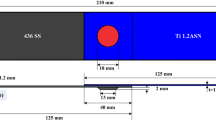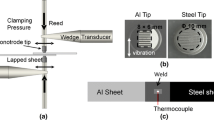The formation of ultrasonic spot welds of AA6111-T4 has been investigated using a single-transducer unidirectional wedge-reed welder. The evolution of weld microstructures and weld strength due to anvil cap geometry and welding energy was studied. The variations in lap-shear failure load and weld microstructures as a function of welding energy were only slightly influenced by the changes in the anvil cap geometry. Weld failure in lap-shear tensile tests occurs by interface fracture for low energy welds and by button formation for high energy welds. Initially, microwelds or weld islands several microns in diameter are generated presumably at asperities of the two pieces being joined. As the welding energy increases, the weld interface can change from a planar to a wavy morphology and the weld strength increases. Deformation wakes and bifurcation are ubiquitous in strong welds. Microporosity is observed at the periphery of growing weld islands and along the flow lines associated with the wavy deformation microstructures. Grain growth occurs inside the weld zone after isothermal annealing. However, the porous microstructure at the weld interface is not affected by isothermal annealing. Ultrasonic spot welding of AA6111-T4 aluminum was found to be insensitive to variations in anvil cap size and the knurl patterns investigated in this research.













Similar content being viewed by others
Notes
JEOL is a trademark of Japan Electron Optics Ltd., Tokyo.
References
E. Lara-Curzio, L. Riester, and R. Jahn: Oak Ridge National Laboratory, Oak Ridge, TN, unpublished research, 2001
J.E. Krzanowski: IEEE Trans. Compon., Hybrids Manufact. Technol., 1990, vol. 13 (1), pp. 176–81
N. Murdeshwar, J.E. Krzanowski: Metall. Mater. Trans. A, 1997, vol. 28A, pp. 2663–71
Y.R. Jeng, J.H. Horng: J. Tribol., 2001, vol. 123 (4), pp. 725–31
Y. Gao, C. Doumanidis: ASME J. Manufacturing Sci. Eng., 2002, vol. 124 (2), pp. 426–34
E.A. Neppiras: Ultrasonics, 1965, pp. 128–35
H.P.C. Daniels: Ultrasonics, 1965, pp. 190–96
J.H. Horng: ASME J. Tribol., 1998, vol. 121 pp. 82–89
M.A. Zlatom, A.A. Kozhushko: Sov. Phys.-Techn. Phys., 1982, vol. 27 (2), pp. 212–14
J.D. Colvin, M. Legrand, B.A. Remington, G. Schurtz, S.V. Weber: J. Appl. Phys., 2003, vol. 93 (9), pp. 5287–5301
Q. Han, C.L. Xu, G.R. Romanoski, D.T. Hoelzer, M.M. Menon, and R.P. Taleyarkhan: 2003 LDRD Seed Funding Project Report No. 3210–2038, Oak Ridge National Laboratory, Oak Ridge, TN, 2003
M.R. Arnison, K.G. Larkin, C.J.R. Sheppard, N.I. Smith, C.J. Cogswell: J. Microsc., 2004, vol. 214 (1), pp. 7–12
J.B. Jones and J.J. Powers: Weld. J., 1956, pp. 761–66
S.T.J. Yu and R. Jahn: TMS Proc. Modeling the Performance of Engineering Structural Materials III, TMS, Warrendale, PA, 2002, pp. 385–91
A. Brodyanski, C. Born, M. Kopnarski: Appl. Surf. Sci., 2005, vol. 252 pp. 94–97
J. Woltersdorf, E. Pippel, E. Roeder, G. Wagner, J. Wagner: Physica Status Solidi A, 1995, vol. 150 (1), pp. 307–17
T. Watanabe, A. Yanagisawa, S. Sunaga: Metall. Mater. Trans. A, 2003, vol. 34A, pp. 1107–11
J.E. Krzanowski, N. Murdeshwar: J. Electron. Mater., 1990, vol. 19 (9), pp. 919–28
E.A. Kenik, R. Jahn: Microsc. Microanal., 2003, vol. 9 pp. 720–21
S.M. Allameh, C. Mercer, D. Popoola, W.O. Soboyejo: J. Eng. Mater. Technol., 2005, vol. 127 (1), pp. 65–74
A.A. Bahrani, T.J. Black, B. Crossland: Proc. R. Soc. Ser. A, 1966, vol. 296 (1445) pp. 123–36
J.N. Hunt: Phil. Mag. (Ser. 8), 1968, vol. 17 (148), pp. 669–80
G.R. Cowan, O.R. Bergmann, A.H. Holtzman: Metall. Trans., 1971, vol. 2, pp. 3145–55
J.L. Robinson: Phil. Mag., 1975, vol. 31 (3), pp. 587–97
J.L. Robinson: J. Appl. Phys., 1977, vol. 48 (6), pp. 2202–07
S.V. Bazdenkov, V.F. Demichev, D.K. Morozov, O.P. Pogutse: Combust. Explos. Shock Waves, 1985, vol. 21 (1), pp. 124–30
V.M. Kornev, I.V. Yakovlev: Combust. Explos. Shock Waves, 1984, vol. 20 (2), pp. 204–07
V.M. Kornev and I.V. Yakovlev: Metall. Appl. Shock-Wave and High-Strain-Rate Phenomena, 1986, pp. 961–67
D. Jaramillo, V.A. Szecket, O.T. Inal: Mater. Sci. Eng., 1987, vol. 91 (7), pp. 217–22
A. Chiba, M. Nishida, Y. Morizono: Mater. Sci. Forum, 2004, vols. 465–466, pp. 465–74
C.H. Oxford, P.E.J. Flewitt: Metall. Trans. A, 1977, vol. 8 (5), pp. 741–50.
S.K. Salwan: India Weld. Res. Inst., 1987, vol. 8 (3), pp. 49–52
F. Grignon, D. Benson, K.S. Vecchio, M.A. Meyers: Int. J. Impact Eng., 2004, vol. 30 (10), pp. 1333–51
Acknowledgments
The authors thank Mr. L. Reatherford for the effort in custom designed anvil post and Drs. S. Ward, W. Donlon, and J.E. Allison for in-depth discussion of the manuscript. This research is supported, in part, by NIST ATP Cooperative Agreement No. 70NANB3H3015 of the United States of America.
Author information
Authors and Affiliations
Corresponding author
Additional information
Manuscript submitted May 19, 2006.
Rights and permissions
About this article
Cite this article
Jahn, R., Cooper, R. & Wilkosz, D. The Effect of Anvil Geometry and Welding Energy on Microstructures in Ultrasonic Spot Welds of AA6111-T4. Metall Mater Trans A 38, 570–583 (2007). https://doi.org/10.1007/s11661-006-9087-0
Published:
Issue Date:
DOI: https://doi.org/10.1007/s11661-006-9087-0




